Scientists asked people to add 2 tablespoons of olive oil to their daily meals. They tracked what happened. The results surprised even the researchers.
High cholesterol affects millions of people. It clogs arteries. It raises heart disease risk. But a small change to your diet can make a real difference.
Think of olive oil as your heart’s best friend. For 8 weeks, try adding it to your food. That’s it. Two months to see if this works for you. No complex rules. No special equipment. Just olive oil and a bit of patience.
What Your Cholesterol Numbers Really Mean
Before we talk about olive oil, let’s make sure you understand your numbers. Cholesterol tests can feel confusing. But they’re simpler than you think.
Total cholesterol should stay under 200 mg/dL. That’s all your cholesterol types combined. But the total doesn’t tell the whole story.
LDL cholesterol is the “bad” kind. It sticks to artery walls. Over time, it builds up and blocks blood flow. You want this number under 100 mg/dL. Ideally, it stays closer to 70 mg/dL if you have heart disease risk.
HDL cholesterol is the “good” kind. It picks up extra cholesterol and carries it away. Men need at least 40 mg/dL. Women need at least 50 mg/dL. Higher is better.
The ratio matters too. Doctors divide your total cholesterol by your HDL. A ratio under 5 is decent. Under 3.5 is great.
When should you try diet changes first? If your LDL is only slightly high and you have no other risk factors, food swaps often work. But talk to your doctor if your LDL is very high or if you have diabetes, high blood pressure, or a family history of heart disease. You might need both medication and diet changes.
Think of your cholesterol like a bank account. LDL is money going out. HDL is money coming back in. You want more coming in than going out.
The Science-Backed Secret to Better Cholesterol: What the Research Really Says
Researchers watched people’s cholesterol for 8 weeks. Each person added olive oil to their diet. The results weren’t tiny. They were clear.
A study published in BMC Nutrition in 2018 tested this exact approach. The research team at the University of North Carolina worked with 91 overweight adults. Half followed their normal American diet. The other half switched to a Mediterranean-style diet rich in olive oil. After 8 weeks, the olive oil group showed lower cholesterol levels. They also had fewer markers of oxidative stress—the cell damage that ages your body.
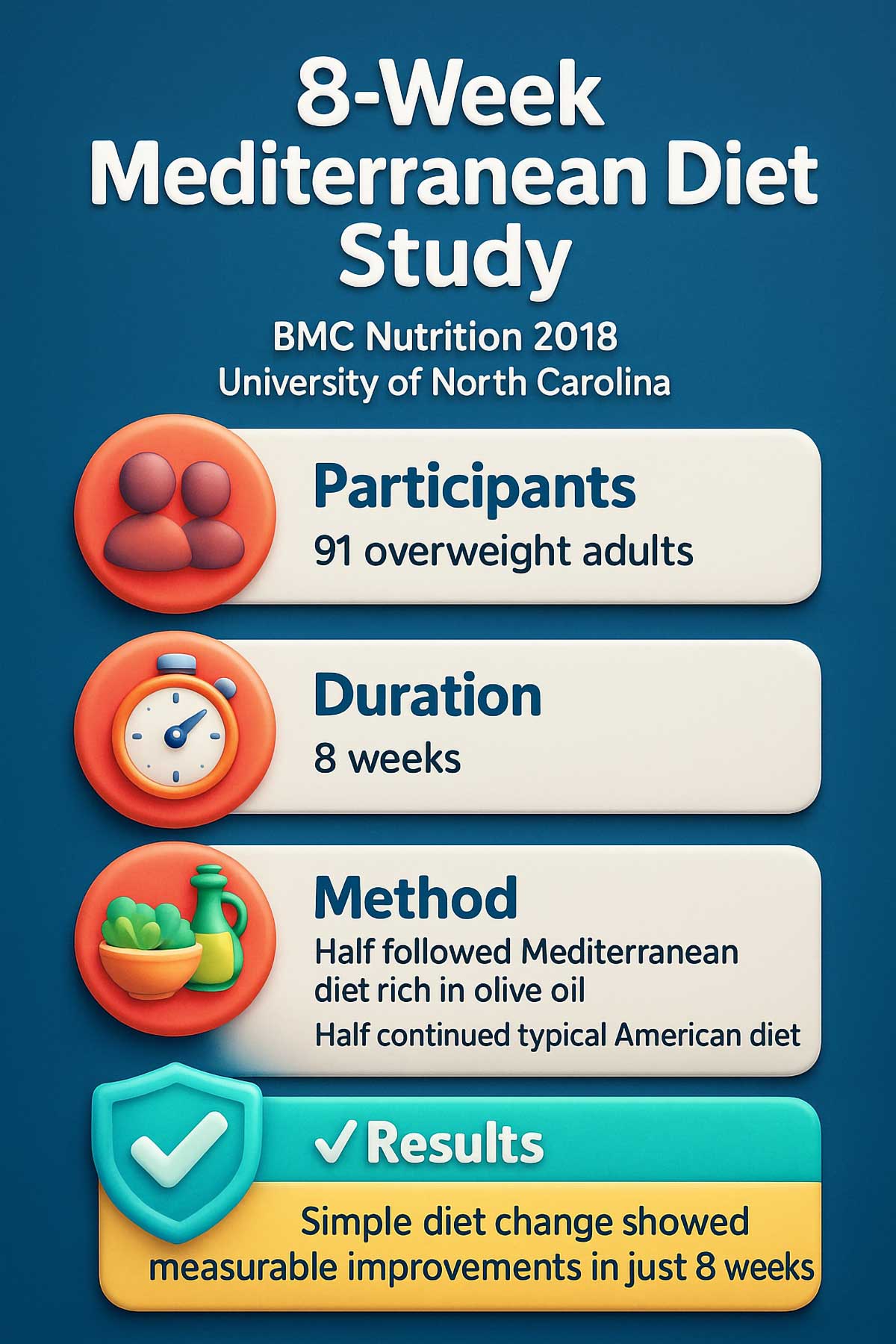
But one study isn’t enough. So scientists looked at dozens of trials together. A 2023 review in the British Journal of Nutrition analyzed multiple studies on olive oil and blood fats. The researchers examined different doses and durations. They found the same pattern over and over. When people ate olive oil instead of butter or other fats, their LDL cholesterol went down. The effects were modest but consistent across studies.
The drop wasn’t huge in every person. But it was steady. It was real. And it happened without drugs.
So why does olive oil work? Two reasons.
First, it contains fats called monounsaturated fats. These fats don’t raise your LDL like butter does. They keep your cholesterol stable. Some studies show they even help your body clear out extra cholesterol.
Second, olive oil has plant compounds called polyphenols. These act like tiny shields. They protect your LDL from damage. Damaged LDL is what really hurts your arteries. Polyphenols stop that process before it starts.
Think of it this way: butter is like adding fuel to a fire. Olive oil is like turning down the heat. Your body handles it better. Your arteries thank you.
Your 8-Week Olive Oil Timeline: What to Expect
| Week | What’s Happening in Your Body | What You Might Notice |
|---|---|---|
| Week 1-2 | Polyphenols begin protecting LDL from damage | Better digestion, more energy after meals |
| Week 3-4 | HDL starts working more efficiently | Feeling fuller longer, fewer cravings |
| Week 5-6 | LDL cholesterol levels begin to drop | Improved mood, better sleep quality |
| Week 7-8 | Oxidative stress markers decrease | More consistent energy, clearer thinking |
| After 8 weeks | Get blood work to see your new numbers | Measurable cholesterol improvements |
A 2013 study in the British Journal of Nutrition revealed something fascinating about HDL function. Researchers at King Saud University gave 24 healthy adults 25 mL of extra virgin olive oil daily for 12 weeks. They measured how well HDL removed cholesterol from cells. After 12 weeks, HDL became about 12-15% more effective at this crucial job. That’s not just about numbers on a test. It’s about how well your body protects itself.
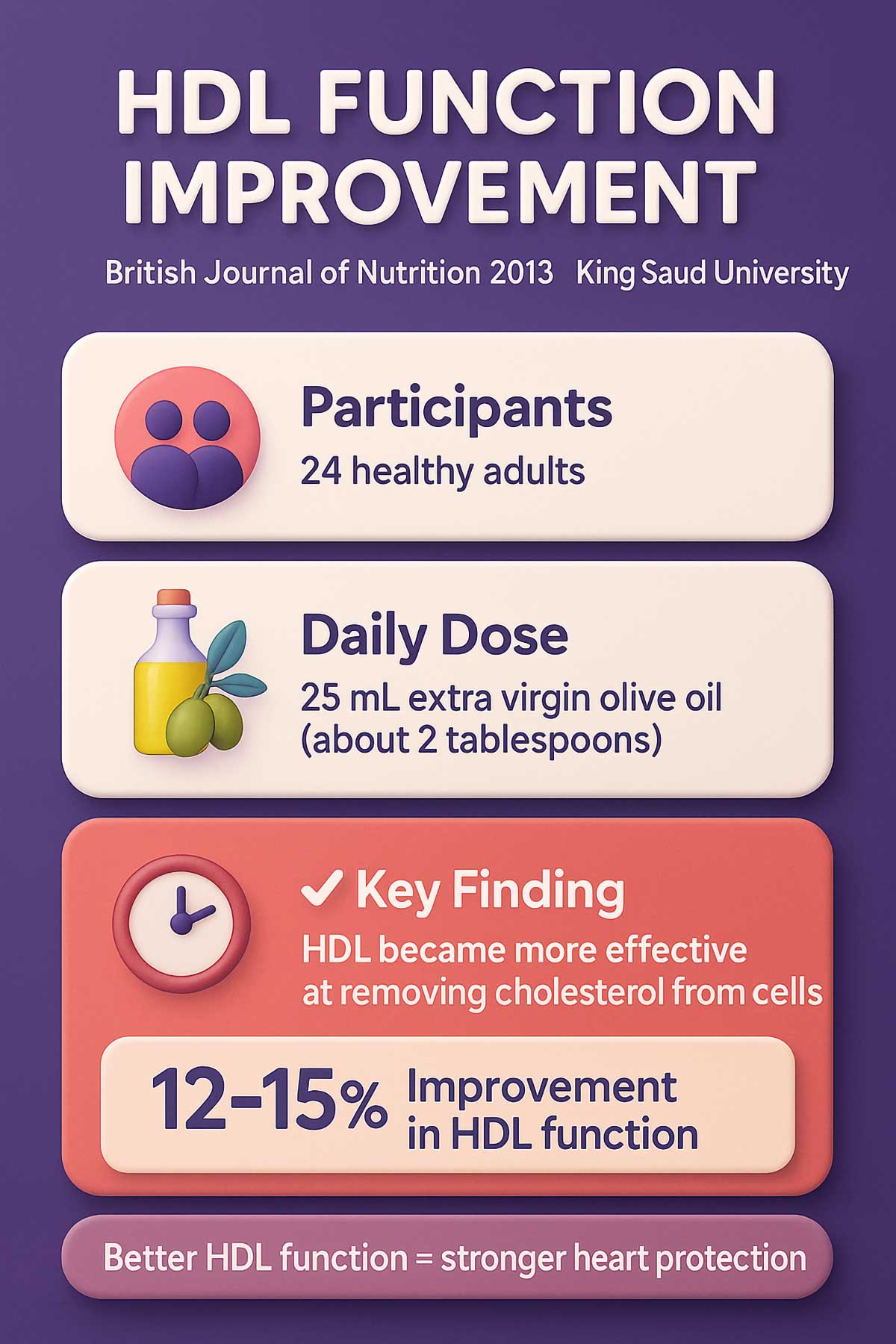
Not All Olive Oils Are Created Equal: Your Guide to Choosing the Right One
Walk into any store. You’ll see dozens of olive oil bottles. They look the same. But they’re not.
Extra virgin olive oil is what you want. It has the most polyphenols. It gives you the most benefit. Other types are refined. They lose those helpful compounds during processing.
A landmark study called EUROLIVE proved this. The 2006 research published in Annals of Internal Medicine involved 200 healthy adults across five European countries. Everyone got 25 mL of olive oil daily for three weeks. But the oils had different polyphenol levels—low, medium, or high. The high-polyphenol oil won. It lowered oxidized LDL better than the low-polyphenol version. Same dose. Same duration. But different quality made different results.
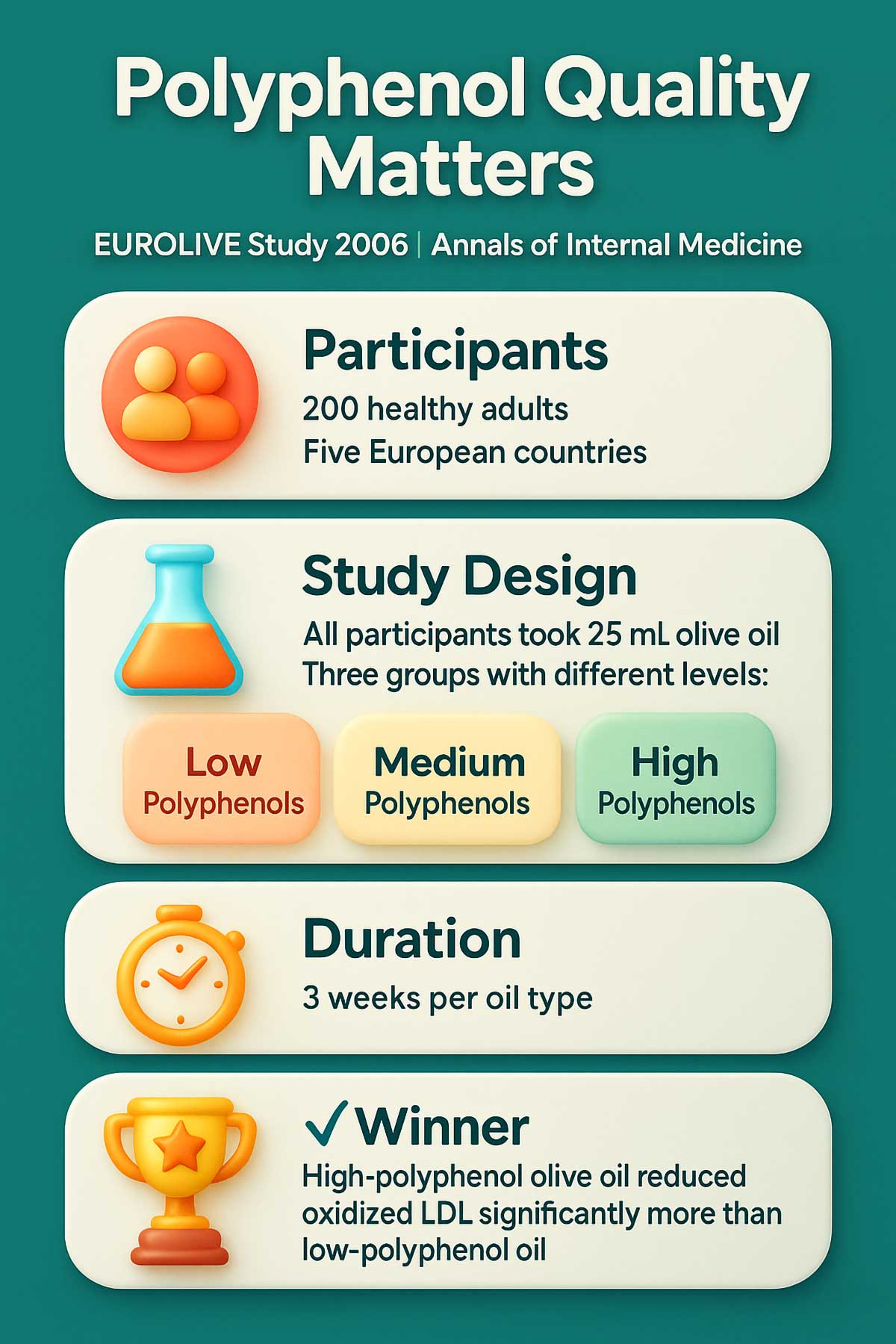
Your body gets more protection from better oil. It’s worth the extra cost.
Decode Your Olive Oil Label
| What to Look For | Why It Matters | Red Flags to Avoid |
|---|---|---|
| “Extra Virgin” designation | Only type with full polyphenols | “Pure,” “Light,” “Refined” |
| Harvest date (within 18 months) | Fresher = more potent | Only “best by” date listed |
| Dark glass or tin container | Protects from light damage | Clear plastic bottles |
| Single origin or estate | Quality control, traceability | “Product of multiple countries” |
| Certification seals (COOC, PDO, PGI) | Third-party quality verification | No certifications |
| Peppery/bitter taste notes | Indicates polyphenol content | “Mild,” “Buttery” only |
Here’s how to shop smart:
Look for “extra virgin” on the label. That’s the first press. It keeps the most nutrients.
Check for a harvest date. Fresh oil works best. Try to buy oil from the most recent harvest. Aim for bottles less than 18 months old.
Choose dark bottles. Light breaks down polyphenols. Dark glass or tin protects them.
Store it right. Keep your bottle in a cool, dark place. Heat and light destroy the good stuff fast. Don’t leave it next to your stove.
Does the oil taste a bit bitter or peppery? That’s good. Those flavors come from polyphenols. A smooth, bland oil probably has fewer of them.
Pro Tip: Taste your olive oil straight. High-quality oil should make you cough slightly—that’s the polyphenols working! If it slides down smooth with no bite, it probably won’t give you the health benefits you’re after.
Price matters, but not always. Expensive doesn’t guarantee quality. But very cheap oil is often refined. Look for certifications or awards if you can.
One more tip: buy smaller bottles. Once you open olive oil, it starts to degrade. A smaller bottle means you’ll use it while it’s still fresh.
Did You Know? Olive oil stays good longer in the fridge. It will solidify and look cloudy, but it returns to liquid at room temperature. This doesn’t hurt the quality at all.
🫒 Olive Oil Quality Checker
Answer 6 questions to get your quality score
Common Mistakes That Sabotage Your Results
You bought good olive oil. You’re ready to start. But wait. These seven mistakes could waste your time and money.
Mistake 1: Using olive oil that’s too old
Check the harvest date before you buy. Once you open the bottle, use it within 3-4 months. Old oil loses its polyphenols. It won’t hurt you. But it won’t help your cholesterol either.
Mistake 2: Cooking at too high heat
Extra virgin olive oil has a smoke point around 375°F. Go higher and you destroy the polyphenols. For high-heat cooking above 400°F, use avocado oil instead. Save your olive oil for medium-heat cooking and raw uses.
Mistake 3: Storing near the stove
Heat, light, and air are olive oil’s enemies. That pretty bottle by your stove looks nice. But the heat makes it go bad fast. Keep it in a cupboard away from your stove and oven.
Mistake 4: Buying huge bottles
A gallon jug seems like a good deal. But can you use it in 3-4 months? Probably not. Stick with 500 mL to 750 mL bottles. Buy fresh more often.
Mistake 5: Expecting results without replacing other fats
Adding olive oil on top of butter doesn’t work. You need to swap one for the other. Otherwise, you’re just eating more fat. Your cholesterol won’t budge. Your weight might go up.
Mistake 6: Using too little
One teaspoon won’t cut it. The studies used about 2 tablespoons daily. That’s 30 mL. Measure it at first. You might be surprised how much that actually is.
Mistake 7: Choosing refined oils labeled as “olive oil”
Plain “olive oil” or “light olive oil” is refined. It has almost no polyphenols. You need “extra virgin” on the label. Don’t let marketing fool you.
Fix these mistakes and you’ll see better results. Small details make a big difference.
How Much Olive Oil Do You Really Need?
Two tablespoons sounds simple. But how much is that exactly?
2 tablespoons = 30 mL = 1/8 cup = 6 teaspoons = approximately 1 standard coffee creamer cup
Different goals need different amounts. Here’s your guide.
How Much Olive Oil Do You Really Need?
| Your Goal | Daily Amount | Best Timing | Expected Timeline |
|---|---|---|---|
| Cholesterol management | 2 tablespoons (30 mL) | Split between 2 meals | 8-12 weeks |
| General heart health | 1-2 tablespoons (15-30 mL) | With largest meal | Ongoing |
| Maximum antioxidant benefit | 2-3 tablespoons (30-45 mL) | With meals containing fat-soluble vitamins | 12+ weeks |
| Replacing saturated fats | Match previous fat intake | Throughout the day | 4-8 weeks |
Start with 2 tablespoons for cholesterol. You can split this up. One tablespoon at lunch. One at dinner. Or use both at once. Whatever fits your life.
Pair olive oil with foods that have vitamins A, D, E, and K. These vitamins need fat to get absorbed. Olive oil helps your body use them better. Think salads with carrots or kale. Roasted sweet potatoes. Fish with vegetables.
The 2-Tablespoon-a-Day Challenge: 7 Creative Ways to Get Your Daily Dose
Two tablespoons sounds simple. But how do you fit it into real life? Here are seven ways to make it easy. One for each day of the week.
Monday: Morning Toast Upgrade
Drizzle olive oil over avocado toast. Skip the butter. The oil soaks in. It adds richness. Plus, you start your week strong.
Use 1 tablespoon on your toast. Add another tablespoon to your lunch salad. Done.
Tuesday: Salad Dressing from Scratch
Store-bought dressing has sugar, preservatives, and low-quality oils. Make your own in 30 seconds.
The 2-Tablespoon Mediterranean Salad Dressing
Ingredients:
- 2 tablespoons extra virgin olive oil
- 1 tablespoon fresh lemon juice
- 1 small garlic clove, minced
- 1/4 teaspoon dried oregano
- Pinch of sea salt and black pepper
Instructions: Mix everything in a small jar. Shake well. Pour over 2 cups of greens. This gives you your full daily dose in one meal.
Tip: Double or triple the recipe. Store in the fridge for up to 5 days. Shake before each use. The garlic flavor gets stronger over time.
Wednesday: Dip Transformation
Hummus from the store is fine. But it’s even better with extra olive oil mixed in.
Heart-Healthy Olive Oil & White Bean Dip
Ingredients:
- 1 can (15 oz) white beans, drained and rinsed
- 2 tablespoons extra virgin olive oil
- 1 tablespoon lemon juice
- 1 garlic clove
- 1/4 teaspoon cumin
- Salt to taste
- Extra olive oil for drizzling
Instructions: Put beans, 2 tablespoons olive oil, lemon juice, garlic, cumin, and salt in a blender. Blend until smooth. Transfer to a bowl. Create a small well in the center. Drizzle with more olive oil. Serve with cut vegetables or whole-grain crackers.
Serving size: The recipe makes about 2 cups. Eat 1 cup (half the recipe) to get 1 tablespoon of olive oil. Add another tablespoon to your dinner vegetables for your full daily dose.
Thursday: Soup Finishing Touch
Made soup? Don’t eat it plain. Stir in a tablespoon of olive oil right before serving. It makes the broth taste richer. It ties all the flavors together.
This works with any soup. Tomato. Vegetable. Bean. Chicken. The oil floats on top and coats your spoon with each bite.
Friday: Stir-Fry Swap
Most people use vegetable oil for stir-fries. Switch to olive oil instead. Just keep the heat at medium, not high.
5-Minute Olive Oil Roasted Vegetables
Ingredients:
- 3 cups mixed vegetables (broccoli, bell peppers, zucchini, mushrooms)
- 2 tablespoons extra virgin olive oil
- 2 garlic cloves, sliced thin
- 1/2 teaspoon Italian herbs (or any dried herbs you like)
- Salt and pepper to taste
Instructions: Heat your oven to 425°F. Toss vegetables with olive oil, garlic, and seasonings in a big bowl. Spread them on a baking sheet in a single layer. Roast for 20-25 minutes. Stir them once halfway through. The oil keeps vegetables tender and brings out their natural sweetness.
Serving size: The entire recipe gives you your full 2 tablespoons. Split it between two people and each gets 1 tablespoon. Add another tablespoon to your meal elsewhere.
Saturday: Grilled Protein Topper
Cooked fish or chicken? Don’t stop there. Drizzle olive oil on top while it’s still hot. Add lemon zest or fresh herbs. The oil melts into the protein. It keeps it moist. It adds flavor without sauce or gravy.
This works especially well with plain grilled chicken breast. The oil transforms it from dry and boring to juicy and tasty.
Sunday: Bread Dipping Ritual
Pour olive oil into a small dish. Add cracked black pepper or dried herbs like rosemary. Dip whole-grain bread. It’s simple. It feels special. It’s a perfect end to your week.
Use this as a pre-dinner appetizer. Or make it your light lunch with a side salad. Either way, measure your oil first. Two tablespoons in your dipping dish. When it’s gone, you’re done.
These aren’t rules. They’re ideas. Pick what fits your life. The goal is 2 tablespoons total each day. Split them up. Use them all at once. Whatever works.
Your First Shopping Trip:
- 1 bottle (500 mL) extra virgin olive oil with a harvest date
- Dark glass cruet for daily use (optional but helpful)
- Fresh lemons for dressings
- Vegetables for roasting (pick your favorites)
- Whole grain bread or crackers
- Garlic and dried herbs
Can You Have Too Much Olive Oil?
Yes. More isn’t always better.
Each tablespoon has 120 calories and 14 grams of fat. Two tablespoons add 240 calories to your day. That’s fine if you’re replacing butter or other oils. But if you’re adding olive oil on top of everything else, you’ll gain weight.
The upper safe limit is about 4-5 tablespoons per day. After that, the benefits don’t increase. You’re just adding extra calories.
Signs you’re using too much:
- Digestive upset or loose stools
- Weight gain despite eating healthy foods
- Feeling too full or greasy after meals
- Your total daily fat intake is over 35% of calories
Think about your total fat intake. If you eat nuts, avocados, cheese, and meat, you’re already getting fat. Add olive oil to that. Don’t go overboard.
The sweet spot for most people is 2-3 tablespoons daily. That’s enough for cholesterol benefits. It’s not so much that it causes problems.
Balance matters. Olive oil is healthy. But it’s not magic. You still need vegetables, protein, and whole grains. You still need to move your body. You still need to manage stress.
Think of olive oil as one tool in your toolkit. Use it right and it works great. Overuse it and you create new problems.
The Other Remarkable Health Benefits of Olive Oil
Olive oil does more than fix your cholesterol numbers. It helps your whole body.
How Olive Oil Boosts Your “Good” Cholesterol
HDL cholesterol doesn’t just float around. It has a job. It pulls extra cholesterol out of your cells and artery walls. Then it carries that cholesterol to your liver for removal.
But not all HDL works the same. Some HDL is lazy. Some HDL is active and effective. Olive oil makes your HDL work harder.
That 2013 study from King Saud University measured this exactly. After 12 weeks of 25 mL daily olive oil, people’s HDL became 12-15% better at pulling cholesterol from cells. The researchers called this “cholesterol efflux capacity.” Think of it as HDL’s cleaning power. Olive oil cranks up that power.
The Anti-Inflammation Effect You Can’t See
Your cells face damage every single day. Pollution in the air. Stress at work. Even normal metabolism creates harmful compounds called free radicals. These beat up your cells. Over time, this damage piles up. It causes inflammation. Chronic inflammation leads to heart disease, diabetes, and other problems.
Olive oil fights this process. The polyphenols act like repair workers. They neutralize free radicals before they cause harm. They calm inflammation at the cellular level.
A 2019 review published in Frontiers in Nutrition looked at 30 different studies on olive oil. The researchers found consistent anti-inflammatory effects. People who ate olive oil regularly had lower levels of inflammatory markers in their blood. This happened alongside the cholesterol improvements.
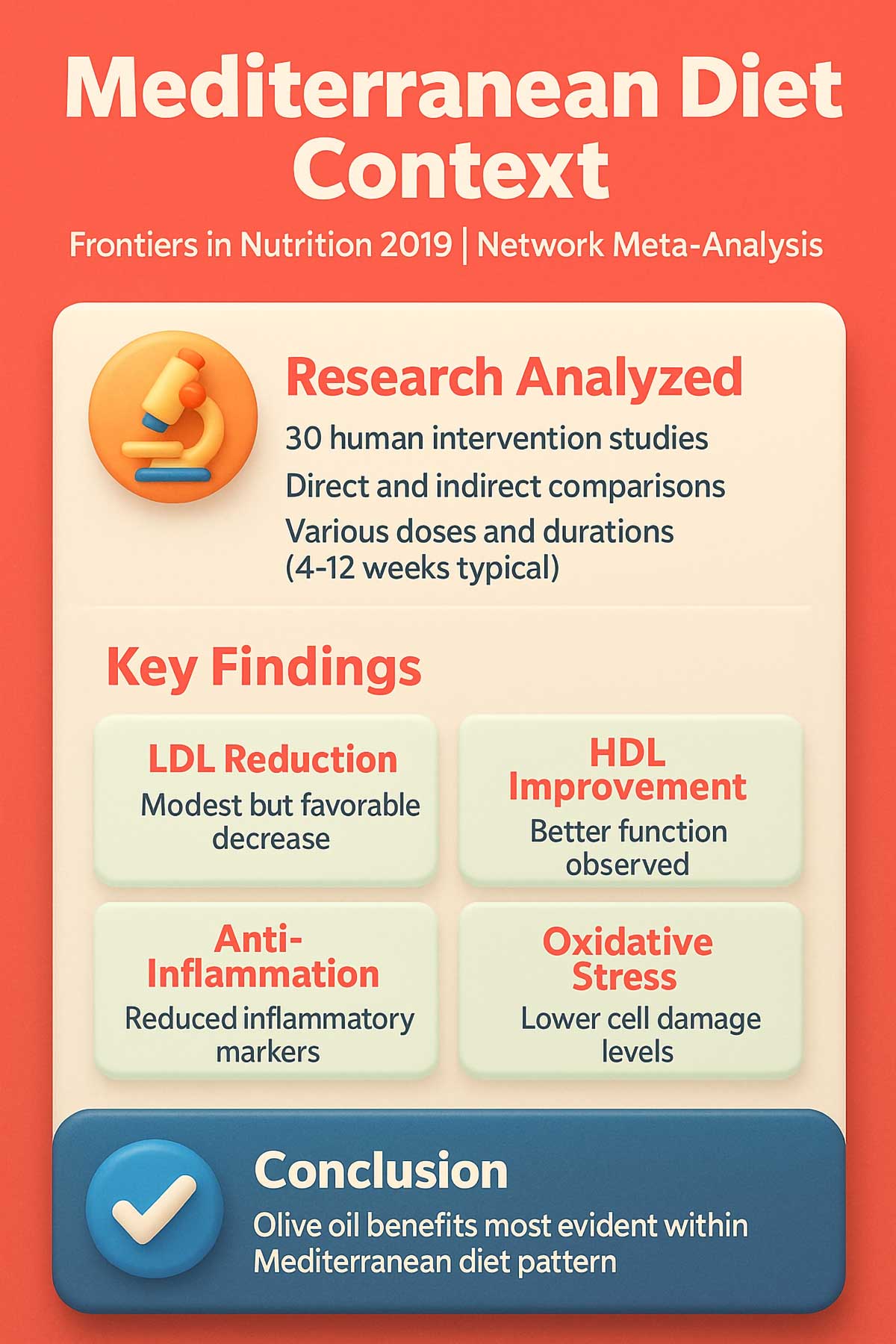
You won’t feel this working. There’s no immediate signal. But your body knows. Your cells are healthier. Your risk of disease drops. The effects build over months and years.
Bonus Benefits: Brain Health and Blood Sugar
The research on olive oil goes beyond the heart.
Some studies link regular olive oil intake to better memory and thinking. The connection isn’t fully proven yet. But the pattern is promising. The same polyphenols that protect your heart might protect your brain too.
Blood sugar control improves in some people. The healthy fats slow down how fast sugar enters your blood. This helps prevent spikes and crashes. You feel more steady energy throughout the day. This benefit helps people with diabetes or prediabetes.
Your arteries stay more flexible. Stiff arteries are dangerous. They can’t adjust to changes in blood pressure. Olive oil helps keep them elastic. That’s good for your entire circulatory system.
These benefits build over time. Eight weeks is a start. But the longer you use olive oil, the more your body adapts. Think of it as a long-term investment in your health.
Why Replacing Butter with Olive Oil Makes Sense
You probably use butter. Most people do. But what if you swapped it for olive oil?
Scientists tested this exact question in a 2018 study published in BMJ Open. Researchers at the University of Cambridge gave 94 healthy adults 50 grams of fat daily for 4 weeks. Some got butter. Some got coconut oil. Some got extra virgin olive oil. Then they measured cholesterol changes.
Butter raised LDL cholesterol significantly. The increase was about 0.38 mmol/L (roughly 15 mg/dL) higher compared to olive oil. That might sound small. But it adds up. Over months and years, that difference matters a lot.
Olive oil didn’t raise LDL at all. It kept levels stable. Some people even saw small decreases.
Coconut oil fell somewhere in between. It raised LDL more than olive oil but less than butter.
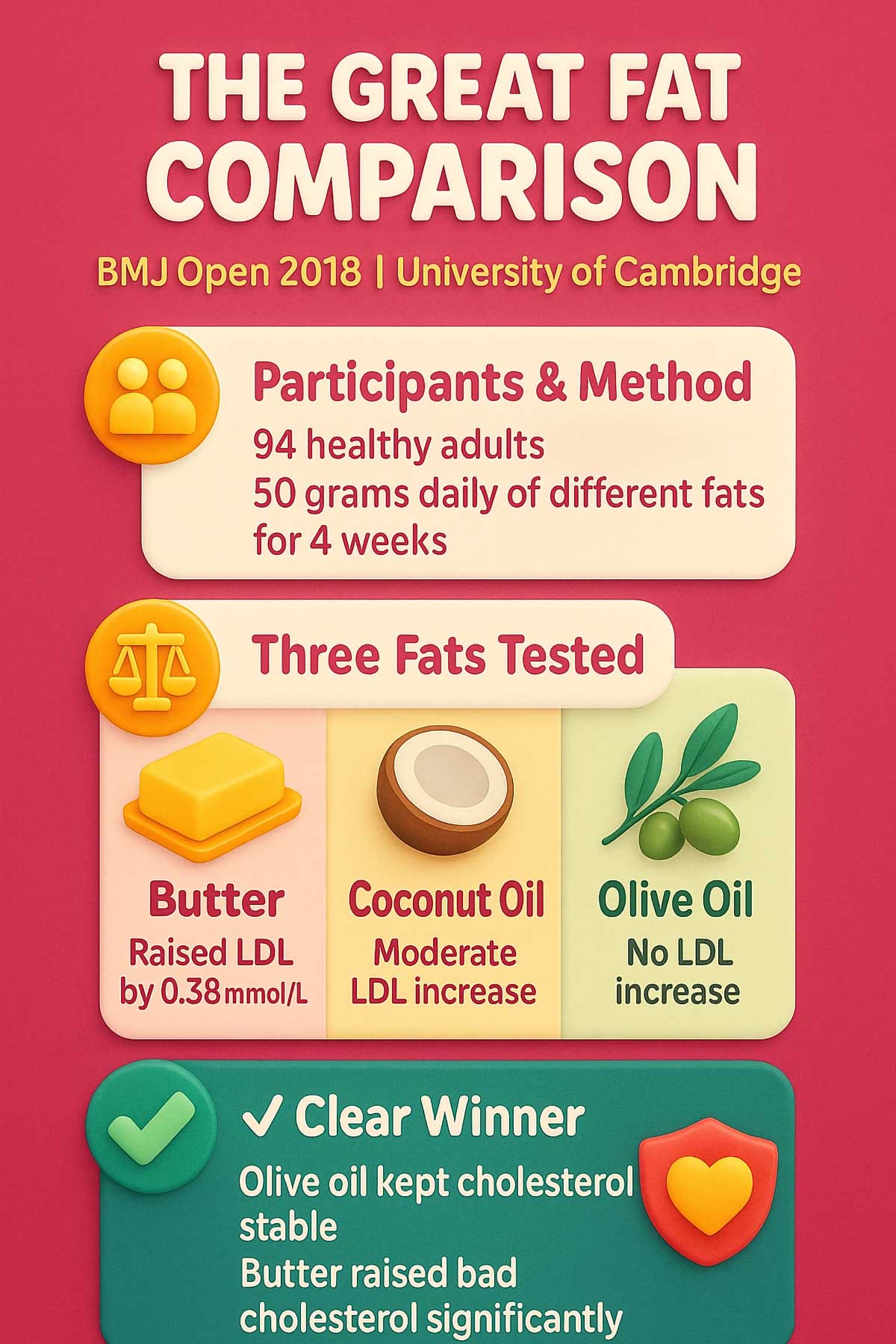
Olive Oil vs. Other Cooking Fats: The Cholesterol Impact
| Fat Type | Effect on LDL (Bad) | Effect on HDL (Good) | Polyphenol Content | Best Uses |
|---|---|---|---|---|
| Extra Virgin Olive Oil | Maintains or lowers | Improves function | High | Raw, light cooking, finishing |
| Butter | Raises significantly | Neutral | None | Occasional use only |
| Coconut Oil | Raises moderately | Neutral | Low | High-heat cooking (if needed) |
| Vegetable Oil (refined) | Variable | Neutral | None | Avoid when possible |
| Avocado Oil | Maintains | Neutral | Moderate | High-heat cooking |
The lesson? Swap butter for olive oil when you can.
Use olive oil on vegetables instead of butter. Bake with it. Drizzle it on potatoes. The taste is different, but you’ll get used to it. And your arteries will feel the difference, even if you don’t.
This isn’t about being perfect. You don’t need to throw out every stick of butter in your house. Just make the swap when it’s easy. Over time, those small changes add up to big results.
A 2023 dose-response analysis published in the British Journal of Nutrition pooled data from multiple studies. The researchers found that replacing just 10 grams of saturated fat (like butter) with olive oil dropped total cholesterol by an average of 0.13 mmol/L and LDL by 0.16 mmol/L. Small numbers, but they’re consistent. And they happen without side effects or prescriptions.
Conclusion
Here’s what you’ve learned: 2 tablespoons of olive oil per day can improve your cholesterol in 8 weeks. Science backs this up. Multiple studies from respected institutions show the same results.
Choose extra virgin olive oil with high polyphenols. Check the harvest date. Store it in a cool, dark place. Use it in creative ways throughout your day. Replace butter and refined oils when you can.
The benefits go beyond cholesterol. Your HDL works better at removing cholesterol from cells. Your body fights inflammation more effectively. Your cells face less oxidative damage. Your whole body gets healthier.
Eight weeks isn’t long. It’s two months. You can try anything for two months. Track how you feel each week using the checklist above. Get your cholesterol tested before and after. See the proof yourself.
Small changes lead to big results. You don’t need a complete life overhaul. Just one simple addition. Two tablespoons a day. That’s your challenge.
Start tomorrow. Or start today. Pick one method from the 7-day list. Buy a bottle of good olive oil on your next shopping trip. Mark week 1 on your calendar.
FAQs
How long does it take for olive oil to lower cholesterol?
Most studies show changes in 4-8 weeks. Some people see results faster. Others take 10-12 weeks. It depends on your starting cholesterol, your genes, and what else you eat. Be patient. Stick with it for at least 8 weeks before deciding if it works.
Can I cook with olive oil or only use it raw?
You can cook with it. Just keep the temperature at or below 375°F. That’s medium heat on most stoves. For high-heat cooking above 400°F, use avocado oil instead. Save olive oil for roasting, sautéing, and finishing.
Will olive oil help if I’m already on statins?
Yes. Olive oil and statins work in different ways. Statins block your liver from making cholesterol. Olive oil protects the cholesterol you have from getting damaged. Using both gives you double protection. But talk to your doctor before making any changes to your medication.
Is expensive olive oil worth it for cholesterol?
Not always. Price doesn’t guarantee quality. Look for harvest dates, dark bottles, and certifications instead. A $20 bottle from a reputable producer often beats a $50 bottle with good marketing. Taste it. If it’s peppery and makes you cough a little, it has polyphenols. That’s what matters.
Can I use olive oil if I’m trying to lose weight?
Yes, but watch your portions. Two tablespoons add 240 calories to your day. If you’re replacing butter or other fats, you’re fine. If you’re adding olive oil on top of everything else, you might gain weight. Measure carefully. Don’t go over 2-3 tablespoons daily.
What if I don’t like the taste of olive oil?
Start with a milder extra virgin oil. Strong, peppery oils can be intense. Mix olive oil with lemon juice or vinegar in dressings. The acid balances the flavor. Or try it in cooked dishes first. Heat mellows the taste. As you get used to it, you might start to enjoy the peppery bite.
Should I take olive oil supplements instead?
No. Supplements don’t work the same way. The studies all used actual olive oil, not pills. You need the whole food—the fats, the polyphenols, everything together. Plus, oil supplements can go rancid. They don’t absorb as well. Stick with real olive oil.
How do I know if my olive oil has gone bad?
Smell it. Rancid oil smells like crayons, old nuts, or Play-Doh. Fresh oil smells fruity and green. Taste it. Bad oil tastes stale, greasy, or metallic. Good oil tastes fresh with a peppery finish. If your oil is more than 18 months past its harvest date or has been open for more than 4 months, replace it.
Can children have olive oil for cholesterol?
Talk to your pediatrician first. But yes, olive oil is safe and healthy for kids. It’s better than butter for the whole family. Just adjust portions. A child might only need 1 tablespoon daily, not 2. Make it part of family meals, not a medical treatment.
Do I need to take olive oil on an empty stomach?
No. Take it with meals. The fat helps you absorb vitamins from your food. It also keeps you full longer. Some people take a spoonful straight in the morning, but that’s not necessary. Just work it into your regular meals.



